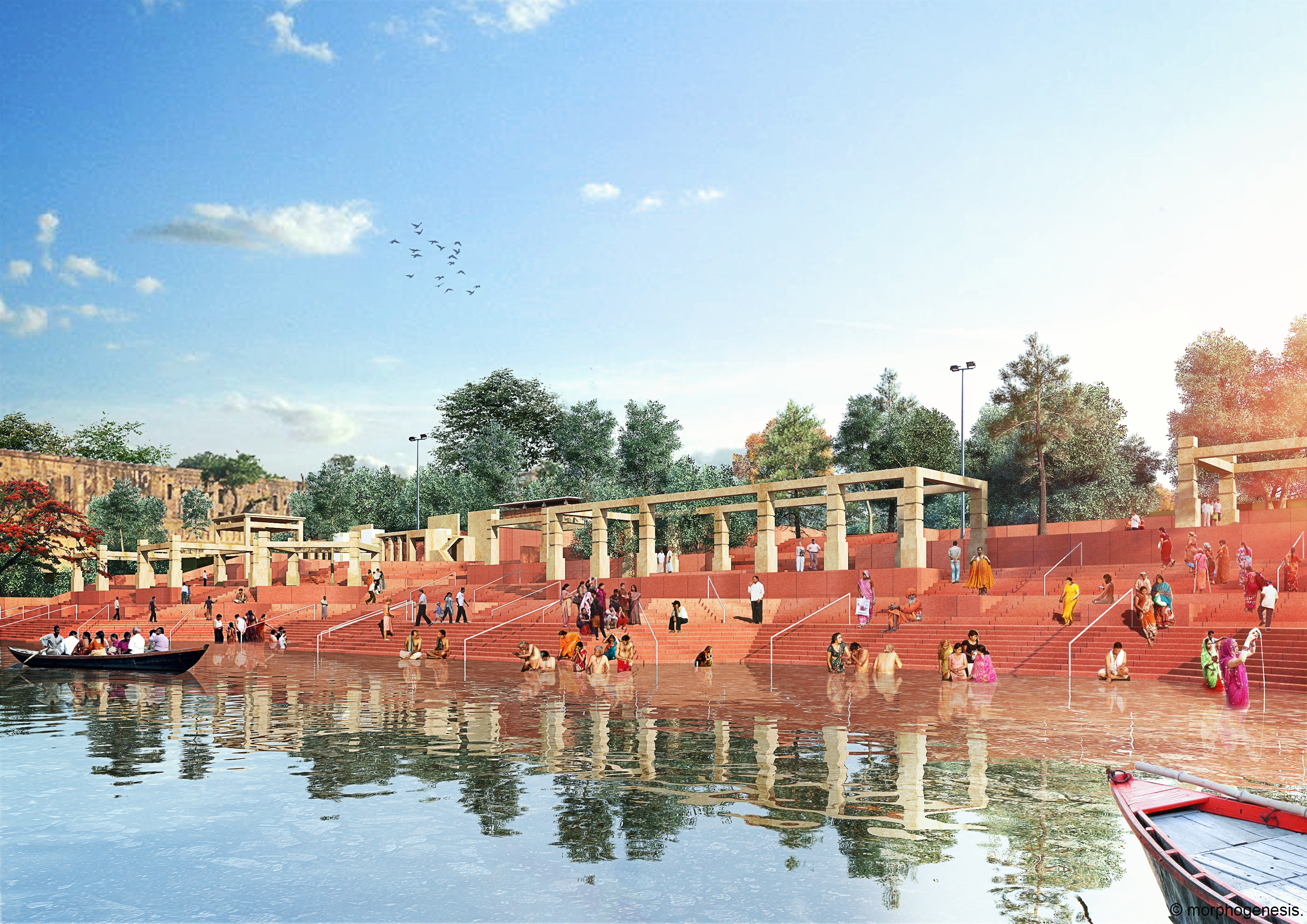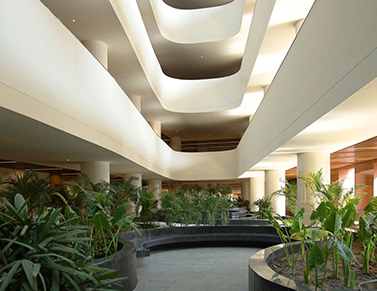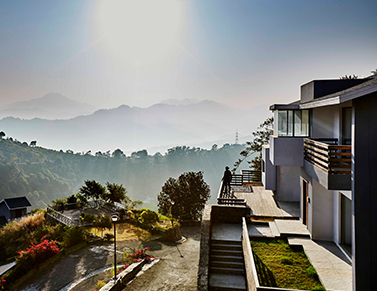The art of gardening is an important part of Japanese culture when it comes to landscaping, as discussed in Part 1. The garden design is strongly connected to the philosophical, historical and cultural aspect of the country.[1]
Gardens in Japan are of two distinct types, one which are experienced by walking through them and others those are simply viewed from a distant building or a veranda. The various gardens are categorized by expression of one or several elements present in the garden. These garden styles are also decided not only by their appearance but also by size and purpose of the garden. [2] In this blog we will go through various garden styles of Japanese landscape.
Pond or Island Gardens
he oldest style of garden in Japan, also called as ‘Chisen-shoyū-teien’ was imported from China during the Heian period (794-1185)[1]. Heian period is the era when Buddism, Taoism and Chinese influences were at their peak. The times were also noted for Japanese imperial court patronized art, poetry and literature [1].
The pond, which serves as the central organizing feature for the more modern stroll garden, [4] could contain large lakes with small islands where musicians played during festivals [1]. The ponds were of irregular outline, dotted with large boulders and an island would break the surface of the water. The garden was also considered to be a sacred space and a place to attract gods.[5]
The garden would typically feature a long ornate residence, with wings extended in pavilions where guests could enjoy views of the lake.[2]
![The view of the garden with an island [5]](https://www.morphogenesis.org/wp-content/uploads/2017/01/The-view-of-the-garden-with-an-island-5-300x199.jpg)
![Ohori Japanese Garden, Fukuoka [6]](https://www.morphogenesis.org/wp-content/uploads/2017/01/Ohori-Japanese-Garden-Fukuoka-6.jpg)
The Paradise Garden appeared in the late Heian period, meant to symbolize Paradise or the ‘pure land’, where the Buddha sat on a platform on a lotus pond, contemplating [1]. Nakajima, a lake island, where the Buddha hall was created was featured in these gardens and connected to the shore by an arch shaped bridge [1]. These ‘jodo’ gardens were introduced to Japan by Buddhist followers and people from the Amida sect [7].
![Byodin temple, Kyoto [8]](https://www.morphogenesis.org/wp-content/uploads/2017/01/Byodin-temple-Kyoto-8-300x200.jpg)
![Garden pond with phoenix hall in Byodin temple.[7]](https://www.morphogenesis.org/wp-content/uploads/2017/01/Garden-pond-with-phoenix-hall-in-Byodin-temple.7-200x300.jpg)
Karesansui dry rock gardens
Japanese rock gardens, become popular in Japan in the 14th century, when Muso Soseki, the Buddhist monk, built Zen gardens at the five monasteries in Kyoto [1]. White sand / raked gravel in place of water are the major feature for these gardens. [1]
Karensansui means literally ‘dry mountain water’. Gravel, is the most common way of ground cover treatment in these kind of gardens, majorly representing the ocean. [2] The purpose for these gardens is to facilitate meditation, and they are meant to be viewed while seated on the porch of the residence or the abbot of the monastery. [2]
The most famous examples for this style is Ryoan-ji temple in Kyoto.
![Ryoan-ji temple in Kyoto.[9]](https://www.morphogenesis.org/wp-content/uploads/2017/01/Ryoan-ji-temple-in-Kyoto.9-300x193.jpg)
![Zuiho-in garden [10]](https://www.morphogenesis.org/wp-content/uploads/2017/01/Zuiho-in-garden-10-300x225.jpg)
They were created during Muromachi period (1333-1573) and Momoyama period (1573-1600) as a setting for the Japanese tea ceremony. [1] The garden features the path to the teahouse, which is supposed to inspire the visitor to proceed for the ceremony [1], the outer garden, has a gate, covered arbour where guests wait for the invitation to enter. [1]
Then people pass to the inner garden, where they wash their hands and rinse their mouth, before entering the shrine area and thereby going to the teahouse. The path is always green and moist, like a mountain path, but there are no bright flowers on the way. The tea house with no windows is often composed with stepping stones. [2]
A pathway (roji) with stepping stones and lanterns is carefully placed amidst the wooden setting leading to the teahouse (Kashintei), connecting the inner and outer gardens. The rustic gardens are designed as a peaceful, natural space where one can detach from the hectic day. [11]
![Jingu chashitsu [12]](https://www.morphogenesis.org/wp-content/uploads/2017/01/Jingu-chashitsu-12-300x225.jpg)
![kenrokuen hanami [13]](https://www.morphogenesis.org/wp-content/uploads/2017/01/kenrokuen-hanami-13-300x225.jpg)
Promenade gardens
Stroll gardens appeared in Japan during Edo period, at the villas of nobles or warlords. The Edo period, was characterized by economic growth, strict social order, a stable population and popular enjoyment of arts and culture [14]. These gardens are intended to be viewed as the visitor walks or strolls around them [2]. They resemble the original pond and island model of garden, centered round a large pond, often with a shoreline.[2]
The two major principles these gardens are based on are ‘hide and reveal’ and ‘borrowing the scenery’. The former uses winding paths, fences, bamboo and buildings to hide the scenery so the visitor would not see it until the person is at the best view point, while the latter takes the advantage of the views of scenery outside the garden, such as mountains and temples.
![The panoramic view of the Rikugi-en Garden from the Fujishiro-toge hill vantage point. Green trees surround a serene lake. [15,16]](https://www.morphogenesis.org/wp-content/uploads/2017/01/The-panoramic-view-of-the-Rikugi-en-Garden-from-the-Fujishiro-toge-hill-vantage-point.-Green-trees-surround-a-serene-lake.-1516-300x145.jpg)
![Garden in Tokyo. Koishikawa korakuen , [17]](https://www.morphogenesis.org/wp-content/uploads/2017/01/Garden-in-Tokyo.-Koishikawa-korakuen-17-300x200.jpg)
![Murinan, Kyoto, Japan [18]](https://www.morphogenesis.org/wp-content/uploads/2017/01/Murinan-Kyoto-Japan-18-300x200.jpg)
![Garden and buildings at Shisen-dō, a Buddhist temple in Kyoto, Japan [19]](https://www.morphogenesis.org/wp-content/uploads/2017/01/Garden-and-buildings-at-Shisen-dō-a-Buddhist-temple-in-Kyoto-Japan-19-300x200.jpg)
References
- https://en.wikipedia.org/wiki/Japanese_garden#Garden_styles
- http://www.jgs.org.uk/gardens/japanese-garden-styles/
- http://www.slideshare.net/ABHISHEKTHEHUSTLER/japanese-landscape-garden-architecture
- http://tclf.org/landscapes/japanese-hill-and-pond-garden
- http://robertketchell.blogspot.in/2013/09/water-and-japanese-garden.html
- http://www.japaneseaudiolessons.com/compare-japanese-audio-courses/
- http://www.gojapango.com/garden/japanese_paradise_gardens.html
- http://www.gojapango.com/japan_picture/albums/upload/kyoto/byodoin_temple/normal_byodoin_temple_IMG_7968.JPG
- https://en.wikipedia.org/wiki/File:RosanjiTeien.jpg
- https://en.wikipedia.org/wiki/File:Zuihou-in2.JPG
- http://japanesegarden.com/learn-more/the-five-gardens/tea-garden/
- https://en.wikipedia.org/wiki/File:Jingu_Chashitsu04.jpg
- https://en.wikipedia.org/wiki/File:2002_kenrokuen_hanami_0123.jpg
- https://en.wikipedia.org/wiki/Edo_period
- https://en.wikipedia.org/wiki/Rikugi-en
- https://en.wikipedia.org/wiki/Rikugi-en#/media/File:Rikugien-10-2009-fujishirotoge02.jpg
- https://en.wikipedia.org/wiki/Koishikawa_K%C5%8Drakuen_Garden#/media/File:Koishikawa_Korakuen_060607.jpg
- https://en.wikipedia.org/wiki/Murin-an#/media/File:Murinan01r.jpg
- https://en.wikipedia.org/wiki/Shisen-d%C5%8D#/media/File:Shisendo_DSC0480.jpg











